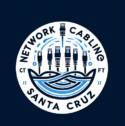What Is the Maximum Speed of a Network Cable? A Complete Guide for Home and Business Networks
If you’ve ever wondered what the maximum speed of a network cable is, you’re not alone. With so many types of Ethernet cables available — from Cat5e to Cat8 — understanding their speed limits can be confusing. The truth is, your cable type determines how fast your network can transfer data, how far signals can travel, and how reliable your connection is.
In this guide, we’ll break down network cable speeds, explain what affects performance, and help you choose the right cable for your setup — whether it’s a home office, commercial network, or data center. Our team of structured cabling experts in Santa Cruz ensures every installation supports the highest data transmission speeds possible.
Understanding Network Cable Speeds
A network cable (often called an Ethernet cable) carries data between your router, switches, and devices. Its maximum speed depends on two main factors:
- Cable category (Cat rating) – This defines performance standards like bandwidth and data rate.
- Transmission distance – Most cables maintain their top speed only up to 100 meters (about 328 feet).
The faster the cable, the more bandwidth it can handle — which means smoother video calls, faster downloads, and less lag for gaming or streaming.
Ethernet Cable Speed Comparison Chart
Here’s a quick look at the maximum speeds of common network cables:
| Cable Type | Maximum Speed | Bandwidth | Max Distance | Best For |
|---|---|---|---|---|
| Cat5e | 1 Gbps | 100 MHz | 100 m | Basic home and small office networks |
| Cat6 | 10 Gbps | 250 MHz | 55 m (10 Gbps), 100 m (1 Gbps) | Modern offices, smart homes |
| Cat6a | 10 Gbps | 500 MHz | 100 m | High-speed commercial use |
| Cat7 | 10 Gbps+ | 600 MHz | 100 m | Data centers, advanced systems |
| Cat8 | 25–40 Gbps | 2000 MHz | 30 m | Server rooms and short-distance backbones |
Note: Speeds may vary depending on equipment quality and installation conditions.
What Affects the Maximum Speed of a Network Cable
Even the best cable can underperform if your setup isn’t optimized. A few key factors influence cable speed and performance:
- Interference and Crosstalk – Nearby electrical signals or poorly shielded cables can slow down data transfer.
- Cable Length – Performance drops if the cable runs longer than its rated distance.
- Connector Quality – Using cheap or mismatched connectors can cause signal loss.
- Installation Environment – Heat, moisture, and tight bends can degrade signal integrity.
- Network Equipment – Routers, switches, and network cards must support the cable’s rated speed.
Proper installation by a certified network cabling professional ensures you get the full speed your cable is designed to deliver.
Choosing the Right Network Cable for Your Needs
Here’s how to decide which cable type suits your setup:
- For Home Networks: Cat5e or Cat6 are reliable and affordable options for streaming, gaming, and remote work.
- For Small to Mid-Sized Businesses: Cat6a offers future-proofing with high speeds and strong interference protection.
- For Data Centers and Enterprise Use: Cat7 or Cat8 provide the fastest speeds and advanced shielding for high-performance systems.
If you’re installing new infrastructure in California, consider structured cabling using Cat6a or higher for long-term reliability and compliance with state standards. To fully grasp how speed is achieved, it helps to understand how cables transfer data across a network.
Testing and Certification
After installation, professionals test cables using certification tools to confirm that speeds and connections meet performance standards. Testing ensures:
- Proper termination and grounding
- No crosstalk or signal loss
- Compliance with ANSI/TIA and ISO/IEC standards
Certified cables deliver consistent speeds, reducing downtime and ensuring network stability.
Future of Network Cable Speeds
Technology continues to evolve, and Ethernet cabling is keeping up. Cat8 cables already support up to 40 Gbps, and research is underway for even faster standards. For most businesses and homes, Cat6a remains the sweet spot for balancing cost, performance, and scalability.
As data demands grow — especially with cloud computing, 8K streaming, and IoT devices — upgrading your cabling will help you stay ahead of the curve.
Upgrade Your Network for Maximum Speed
Your network is only as fast as the cables that connect it. Whether you’re upgrading your office, improving your home setup, or planning a large-scale structured cabling project, choosing the right Ethernet cable makes all the difference. While modern cables offer impressive performance, older standards can still limit your network — find out what the slowest network cable is and why it matters.
If you’re in California, working with licensed cabling professionals ensures your installation meets local codes and achieves the performance you expect.
Contact your local network cabling experts today to get a system designed for speed, reliability, and future expansion.
